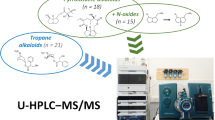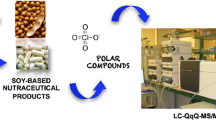Abstract
Maleic hydrazide (MH) is used as a plant growth regulator, herbicide, and sprouting inhibitor for some crops to improve the growth and the quality of some fruits and vegetables so that MH residues should be analyzed in food. Most of the chromatographic analysis methods for MH residues were operated by using ion chromatographic (IC) columns which need complicated with extra washing and conditioning steps. The developed method has overcome this problem by using Synergi polar reversed-phase (RP) column and non-scheduled multiple-reactions monitoring (MRM) scanning modes. Liquid chromatography coupled with negative electrospray ionization triple quadrupole mass spectrometer LC-ESI (-) MS/MS method was developed and validated according to SANTE/12682/2019 at four fortification levels in four food matrices. The method optimization was carried out by using different extracting solvents, LC columns, and mobile phase ratios. The extraction was developed and operated by using 1% formic acid in methanol. The limits of quantification (LOQ) for MH were in the range 0.05–0.1 μg/g that was below the EU maximum residue limit (MRL), set for the studied food matrices such as onion, potatoes, citrus, and grape (15, 50, 0.2, and 0.2 μg/g) respectively. Good method linearity was obtained in the concentration range 0.01–2 μg/ml with correlation coefficients (r2) ≥ 0.99. The average recoveries ranged from 84 to 110% with relative standard deviations RSDs ≤ 17%. The matrix effects on the MH signals were studied and compensated by using the standard addition technique. This polar-RP-LC-ESI (-) MS/MS method was developed to help laboratories which determine the MH residues in food.












Similar content being viewed by others
References
Abdelwahed MH, Khorshid Mona A, El-Marsafy Ashraf M, Souaya E (2019) Validation of short run time LC-ESI (+) MS/MS method for determination of twenty recommended pesticide residues in food based on QuEChERS extraction technique. J Int J Environ Anal Chem 99:409–427
Anastassiades M et al. (2015) Quick method for the analysis of numerous highly polar pesticides in foods of plant origin via LC-MS/MS involving simultaneous extraction with methanol (QuPPe-method) EU reference laboratory for pesticides requiring single residue methods CVUA, Stuttgart, Germany
Attallah ER, Hamdy Abdelwahed M, Abo-Aly M (2018) Development and validation of multi-residue method for determination of 412 pesticide residues in cotton fiber using GC-MS/MS and LC-MS/MS. J Textile Inst 109:46–63
Bursić V, Lazić S, Šunjka D, Ilić Z, Vuković S (2010) Determination of maleic hydrazide residues in onion. J Ratarstvo i povrtarstvo 47:267–272
Chamkasem N (2017) Determination of glyphosate, maleic hydrazide, fosetyl aluminum, and ethephon in grapes by liquid chromatography/tandem mass spectrometry. J Agric Food Chem 65:7535–7541. https://doi.org/10.1021/acs.jafc.7b02419
Chicharro M, Bermejo E, Ongay S, Zapardiel A (2008) Determination of maleic hydrazide in potato samples using capillary electrophoresis with dual detection (UV-electrochemical). J Electroanalysis 20:534–541
Cho R (2000) Rapid analysis of maleic hydrazide in vegetables and fruits using capillary electrophoresis. Food Hyg Saf Sci 41:74–78_71
Dattilo BS, Gallo S, Lionetti G, Rossi S (1994) Determination of free and bound maleic hydrazide residues in tobacco by high performance liquid chromatography. Beiträge zur Tabakforschung International/Contributions Tobacco Res 16:57–64
Deng H et al (2019) Use of autoclave extraction and liquid chromatography tandem mass spectrometry for determination of maleic hydrazide residues in tobacco. J Sep Sci
Dias A, Duncan H (1999) Residues of free and bound maleic hydrazide in potato tubers. Potato Res 42:89–93
EFSA (2011) Review of the existing maximum residue levels (MRLs) for maleic hydrazide according to Article 12 of Regulation (EC) No 396/2005 vol 9. https://doi.org/10.2903/j.efsa.2011.2421
Epstein SS, Mantel N (1968) Hepatocarcinogenicity of the herbicide maleic hydrazide following parenteral administration to infant Swiss mice. Int J Cancer 3:325–335. https://doi.org/10.1002/ijc.2910030302
EurachemGuideline (2014) The fitness for purpose of analytical methods – a laboratory guide to method validation and related topics (2nd ed.)
Fadl K, Abu-Goukh A, El-Balla M (2005) Effect of maleic hydrazide on quality and storability of onions. Sudan J Sci Res 9:53–69
Ganesh S, Kannan M, Jawaharlal M, Jeyakumar P (2014) Growth, physiology and flowering of chrysanthemum var. Punch as affected by daminozide and maleic hydrazide. Afr J Biotechnol:13
Haeberer AF, Schlotzhauer WS, Chortyk OT (1974) A rapid quantitative method for maleic hydrazide. J Agric Food Chem 22:328–330. https://doi.org/10.1021/jf60192a043
Ibrahim YA (2016) Handbook of The Approved recommendations for the control of agricultural pests in Egypt. The Egyptian Agricultural Pesticide Committee (Egypt-APC)
Ilić Z, Filipović-Trajković R, Lazić S, Bursić V, Šunjka D (2011) Maleic hydrazide residues in the onion bulbs induce dormancy and hamper sprouting for long periods Journal of Food. Agric Environ 9:113–118
Islam MN, Bint-E-Naser SF, Khan MS (2017) Pesticide food laws and regulations. In: Khan MS, Rahman MS (eds) Pesticide Residue in Foods. Springer International Publishing, Cham, pp 37–51. https://doi.org/10.1007/978-3-319-52683-6_3
Jankiewicz LS, Kozyra J (1973) Use of maleic hydrazide (MH) to induce branches in maiden fruit trees. Acta Agrobot 26:203–207
Kang W, Hui C, Shaohong X, Yun L (2017) Determination of maleic hydrazide residues in tobacco and tobacco products by SPE-UPLC-MS/MS. Tob Sci Technol
Kubilius DT, Bushway R (1998) Determination of maleic hydrazide in potatoes and onions by capillary electrophoresis. J Agric Food Chem 46:4224–4227
Kubilius DT, Bushway R (1999) Determination of maleic hydrazide in potatoes and onions by fluorescence high performance liquid chromatography. J Liq Chromatogr Relat Technol 22:593–601
Lee WC et al (2001) High performance liquid chromatographic determination of maleic hydrazide residue in potatoes. J Food Drug Anal:9
Lewis DJ, Barnes KA, Wilkinson K, Thorpe SA, Reynolds SL, Startin JR (1996) Extraction of maleic hydrazide residues from potato crisps and their determination using high-performance liquid chromatography with UV and atmospheric pressure chemical ionisation mass spectrometric detection. J Chromatogr A 750:391–396
Mammadova A, Aliyev R, Babayeva S, Abbasov M (2015) Studying the intensity of physiological and genetic processes in plants treated with maleic hydrazide. Albanian J Agric Sci 14:338
Masood A, Ayaz S, Jadoon SA, Alam M, Rab A, Khalil IH, Ayub G, Ali H (2019) Application of maleic hydrazide controlled plant height and ameliorate flower production in local dahlia. Biosci Res 16:1882–1890
Mbwanji K (2014) Inducing mutations in bread wheat (Triticum aestivum L.) using chemical treatments. Stellenbosch: Stellenbosch University
Mertz JL, Lau DY, Borth DM (2006) Liquid chromatographic determination of maleic hydrazide in technical and formulated products: collaborative study. J AOAC Int 89:929–936
Mohamed-Nour IA, Abu-Goukh A-BA (2013) Effect of maleic hydrazide and waxing on ripening and quality of guava (Psidium guajava L.) fruit Gezira. J Agric Sci:11
Moreno CM, Stadler T, da Silva AA, Barbosa LCA, de Queiroz LRME (2012) Determination of maleic hydrazide residues in garlic bulbs by HPLC. Talanta 89:369–376
Newberry GD, Thornton RE (2007) Suppression of volunteer potatoes with maleic hydrazide applications. Am J Potato Res 84:253
Newsome WH (1980) A method for the determination of maleic hydrazide and its beta-D-glucoside in foods by high-pressure anion-exchange liquid chromatography. J Agric Food Chem 28:270–272. https://doi.org/10.1021/jf60228a037
Pan G, Zhao Z, Hu Z, Ye M (2010) Determination of maleic hydrazide in vegetables by high performance ion-exclusion chromatography. Se Pu 28:712–715. https://doi.org/10.3724/sp.j.1123.2010.00712
Ponnampalam R, Mondy NI, Babish JG (1983) A review of environmental and health risks of maleic hydrazide. Regul Toxicol Pharmacol 3:38–47. https://doi.org/10.1016/0273-2300(83)90048-x
Ribas G, Surralles J, Carbonell E, Xamena N, Creus A, Marcos R (1996) Genotoxicity of the herbicides alachlor and maleic hydrazide in cultured human lymphocytes. Mutagenesis 11:221–227. https://doi.org/10.1093/mutage/11.3.221
SANTE/12682/2019 (2019) A guidance document on analytical quality control and method validation procedures for pesticides residues analysis in food and feed. European commission
Sarkar M, Kabir K, Jahan MS, Arefin S (2014) Performance of summer tomato in response to maleic hydrazide. Int J Sci Res Publ 4:556–558
Sarkar MD, Moniruzzaman M, Alam MS, Rahman MJ, Quamruzzaman RNR, Subramaniam S (2019) Growth, sex expression and nutrient composition of cucumber (cucumis sativus) as influenced by maleic hydrazide. J Pakistan J Bot 51:117–123
Shedgel M, Khandekarl R, Bhagwat N (2008) Effect of foliar application of maleic hydrazide and cycocel on growth and yield of sweet potato. J Root Crops 34:20–L28
Siddiqui S, Meghvansi MK, Khan SS (2012) Glyphosate, alachor and maleic hydrazide have genotoxic effect on Trigonella foenum-graecum L. Bull Environ Contam Toxicol 88:659–665
Victor DM, Hall RE, Shamis JD, Whitlock SA (1984) Methods for the determination of maleic hydrazide, ethoxyquin and thiabendazole in wastewaters. J Chromatogr A 283:383–389
Wang L, Fei T, Qi D, Sha Y, Wu D, Liu B (2015) Development of microwave-assisted extraction and liquid chromatography-tandem mass spectrometry for determination of maleic hydrazide residues in tobacco. Anal Methods 7:5103–5107
Ward C, Tucker W (1976) Respiration of maleic hydrazide treated and untreated onion bulbs during storage. Ann Appl Biol 82:135–141
Zeb NS, Khattak M, Hussain AM, Imtiaz (2015) Effect of potassium and maleic hydrazide on growth and flower quality of chrysanthemum (Dendranthema grandiflorum). Sarhad J Agric:31
Zhang H, Tang G, Liu N, Bian Z, Hu Q (2012) The fate of maleic hydrazide on tobacco during smoking. Sci World J 2012:451471–451475. https://doi.org/10.1100/2012/451471
Funding
This work was supported by the Central Laboratory of Residue Analysis of Pesticides and Heavy Metals in Food (QCAP Lab) in Egypt that has been awarded the International Accreditation Certificate in all analysis by the Finnish Accreditation Service based on ISO/IEC 17025.
Author information
Authors and Affiliations
Corresponding author
Ethics declarations
Conflict of interest
Mahmoud Hamdy Abdelwahed declares that she has no conflict of interest. Mona A. Khorshed declares that she has no conflict of interest. Ashraf M. Elmarsafy declares that she has no conflict of interest. Mahmoud S. Elshabrawy declares that she has no conflict of interest. Eglal R. Souaya declares that she has no conflict of interest.
Ethical Approval:
This article does not contain any studies with human participants or animals performed by any of the authors.
Informed Consent:
Informed Consent was obtained from all individual participants included in the study.
Additional information
Publisher’s Note
Springer Nature remains neutral with regard to jurisdictional claims in published maps and institutional affiliations.
Rights and permissions
About this article
Cite this article
Abdelwahed, M.H., Khorshed, M.A., Elmarsafy, A.M. et al. Polar Reversed-Phase Liquid Chromatography Coupled with Triple Quadrupole Mass Spectrometer Method for Simple and Rapid Determination of Maleic Hydrazide Residues in some Fruits and Vegetables. Food Anal. Methods 14, 172–185 (2021). https://doi.org/10.1007/s12161-020-01859-4
Received:
Accepted:
Published:
Issue Date:
DOI: https://doi.org/10.1007/s12161-020-01859-4




